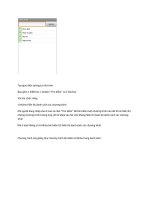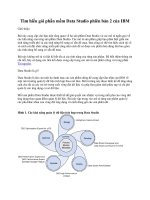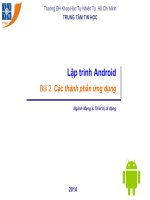Bài giảng Computer Organization and Architecture: Chapter 2
Bạn đang xem bản rút gọn của tài liệu. Xem và tải ngay bản đầy đủ của tài liệu tại đây (1.91 MB, 53 trang )
William Stallings
Computer Organization
and Architecture
6th Edition
Chapter 2
Computer Evolution and Performance
Charles Babbage (1791-1871)
Construction of a machine
called “Difference Engine.”
ENIAC - background
•
•
•
•
•
•
Electronic Numerical Integrator And Computer
Eckert and Mauchly
University of Pennsylvania
Trajectory tables for weapons
Started 1943
Finished 1946
—Too late for war effort
• Used until 1955
ENIAC - details
•
•
•
•
•
•
•
•
Decimal (not binary)
20 accumulators of 10 digits
Programmed manually by switches
18,000 vacuum tubes
30 tons
15,000 square feet
140 kW power consumption
5,000 additions per second
Vacuum tubes
ENIAC
von Neumann/Turing
•
•
•
•
Stored Program concept
Main memory storing programs and data
ALU operating on binary data
Control unit interpreting instructions from
memory and executing
• Input and output equipment operated by control
unit
• Princeton Institute for Advanced Studies
—IAS
• Completed 1952
von Neumann
Von Neumann with the first Institute computer
Alan Turing
Structure of von Neumann machine
IAS - details
• 1000 x 40 bit words
—Binary number
—2 x 20 bit instructions
• Set of registers (storage in CPU)
—Memory Buffer Register
—Memory Address Register
—Instruction Register
—Instruction Buffer Register
—Program Counter
—Accumulator
—Multiplier Quotient
Structure of IAS –
detail
EDVAC
Commercial Computers
•
•
•
•
•
1947 EckertMauchly Computer Corporation
UNIVAC I (Universal Automatic Computer)
US Bureau of Census 1950 calculations
Became part of SperryRand Corporation
Late 1950s UNIVAC II
—Faster
—More memory
UNIVAC I
UNIVAC II
IBM
• Punchedcard processing equipment
• 1953 the 701
—IBM’s first stored program computer
—Scientific calculations
• 1955 the 702
—Business applications
• Lead to 700/7000 series
IBM 701
Transistors
•
•
•
•
•
•
•
•
Replaced vacuum tubes
Smaller
Cheaper
Less heat dissipation
Solid State device
Made from Silicon (Sand)
Invented 1947 at Bell Labs
William Shockley et al.
Transistor Based Computers
• Second generation machines
• NCR & RCA produced small transistor
machines
• IBM 7000
• DEC 1957
—Produced PDP1
IBM 7030 (1961)
DEC PDP-1 (1960)
Estimated cost=$120,000
Microelectronics
• Literally “small electronics”
• A computer is made up of gates, memory cells
and interconnections
• These can be manufactured on a semiconductor
• e.g. silicon wafer
Generations of Computer
• Vacuum tube 19461957
• Transistor 19581964
• Small scale integration 1965 on
—Up to 100 devices on a chip
• Medium scale integration to 1971
—1003,000 devices on a chip
• Large scale integration 19711977
—3,000 100,000 devices on a chip
• Very large scale integration 1978 to date
—100,000 100,000,000 devices on a chip
• Ultra large scale integration
—Over 100,000,000 devices on a chip
Moore’s Law
•
•
•
•
Increased density of components on chip
Gordon Moore cofounder of Intel
Number of transistors on a chip will double every year
Since 1970’s development has slowed a little
— Number of transistors doubles every 18 months
• Cost of a chip has remained almost unchanged
• Higher packing density means shorter electrical paths,
giving higher performance
• Smaller size gives increased flexibility
• Reduced power and cooling requirements
• Fewer interconnections increases reliability









